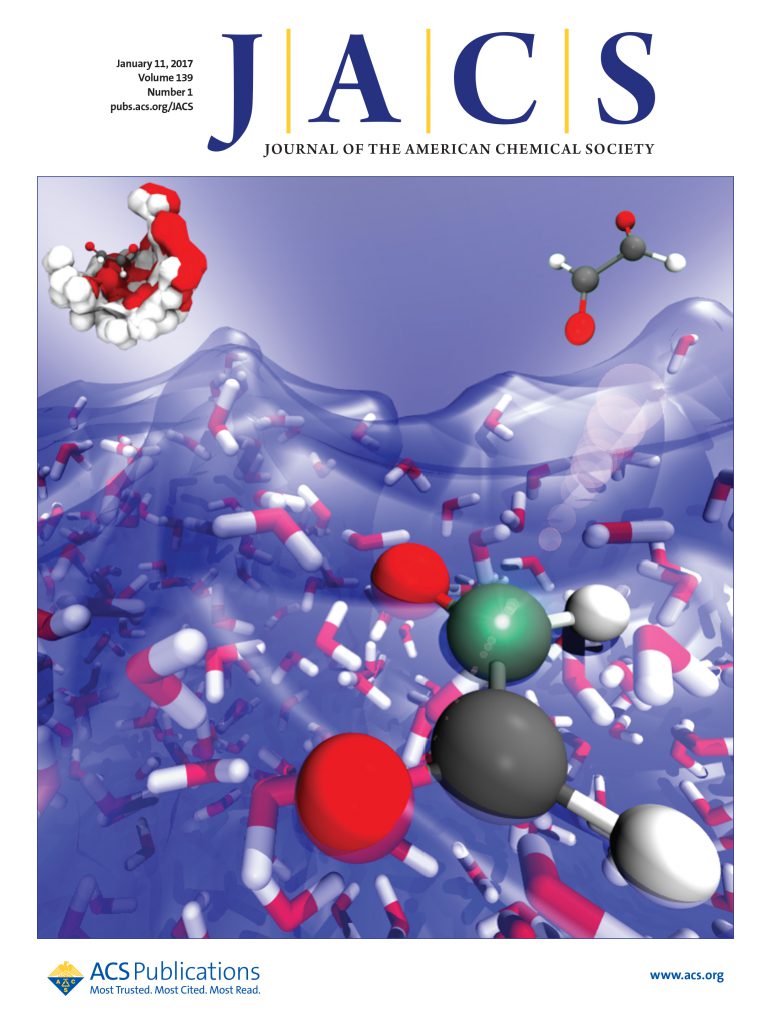一种结构表征的Ni(III)-羟基配合物的碱度控制碳氢键活化。
IF 14.4
1区 化学
Q1 CHEMISTRY, MULTIDISCIPLINARY
引用次数: 0
摘要
强碳氢键的选择性氧化仍然是合成化学的核心挑战,部分原因是活性氧化剂的难以捉摸的性质及其潜在机制。在此,我们报道了室温稳定的单核Ni(III)-羟基配合物[Na(15c5)][Ni(PS3″)(OH)] ([Na(15c5)][2])的分离和完整表征,该配合物由三(苯乙硫代)膦配体衍生物支撑。2的x射线晶体结构显示出一个三角形双锥体Ni(III)中心,其中配位羟基配体通过次级配位球相互作用稳定。配合物2对强C-H键表现出氢原子转移(HAT)反应性,包括环己烷(BDE = 99.5 kcal mol-1)。对各种C-H底物的动力学研究表明,log(k2)与底物pKa之间存在很强的线性相关性,但与C-H键解离能的相关性较差,表明PCET途径是异步的,过渡态主要由质子转移(PT)控制。根据热力学数据估计,得到的Ni(II)-水族的O-H键解离自由能为96.6-100.3 kcal mol-1。半经验的自由能分析遵循Barman等人的方法(Proc. Natl。学会科学。U.S.A. 2021, 118, e2108648118)给出的最佳拟合x值为0.18 (R2 = 0.99),其中x = 1表示同步PCET,较低的值表示过渡态PT特征较大。这些发现强调了碱度在调节PCET反应性中的关键作用,并确定了配合物2是一种罕见的、定义明确的Ni(III)-OH氧化剂,能够在低氧化还原电位下强C-H键激活。本文章由计算机程序翻译,如有差异,请以英文原文为准。
Basicity-Controlled C-H Bond Activation by a Structurally Characterized Ni(III)-Hydroxo Complex.
The selective oxidation of strong C-H bonds remains a central challenge in synthetic chemistry, in part due to the elusive nature of active oxidants and their underlying mechanisms. Herein, we report the isolation and complete characterization of a room-temperature-stable mononuclear Ni(III)-hydroxo complex, [Na(15c5)][Ni(PS3″)(OH)] ([Na(15c5)][2]), supported by a tris(benzenethiolato)phosphine ligand derivative. The X-ray crystallographic structure of 2 reveals a trigonal bipyramidal Ni(III) center, in which the coordinated hydroxo ligand is stabilized by secondary coordination sphere interactions. Complex 2 displays hydrogen atom transfer (HAT) reactivity toward strong C-H bonds, including that in cyclohexane (BDE = 99.5 kcal mol-1). Kinetic studies with various C-H substrates reveal a strong linear correlation between log(k2) and substrate pKa, but a poor correlation with C-H bond dissociation energies, indicating an asynchronous PCET pathway with a transition state predominantly governed by proton transfer (PT). The O-H bond dissociation free energy of a resulting Ni(II)-aqua species was estimated to be 96.6-100.3 kcal mol-1 based on thermodynamic data. A semiempirical free energy analysis following the approach of Barman et al. (Proc. Natl. Acad. Sci. U.S.A. 2021, 118, e2108648118) gives a best-fit x value of 0.18 (R2 = 0.99), where x = 1 indicates synchronous PCET and lower values reflect greater PT character in the transition state. These findings underscore the critical role of basicity in modulating PCET reactivity and establish complex 2 as a rare, well-defined Ni(III)-OH oxidant capable of strong C-H bond activation at low redox potential.
求助全文
通过发布文献求助,成功后即可免费获取论文全文。
去求助
来源期刊
CiteScore
24.40
自引率
6.00%
发文量
2398
审稿时长
1.6 months
期刊介绍:
The flagship journal of the American Chemical Society, known as the Journal of the American Chemical Society (JACS), has been a prestigious publication since its establishment in 1879. It holds a preeminent position in the field of chemistry and related interdisciplinary sciences. JACS is committed to disseminating cutting-edge research papers, covering a wide range of topics, and encompasses approximately 19,000 pages of Articles, Communications, and Perspectives annually. With a weekly publication frequency, JACS plays a vital role in advancing the field of chemistry by providing essential research.

 求助内容:
求助内容: 应助结果提醒方式:
应助结果提醒方式:


